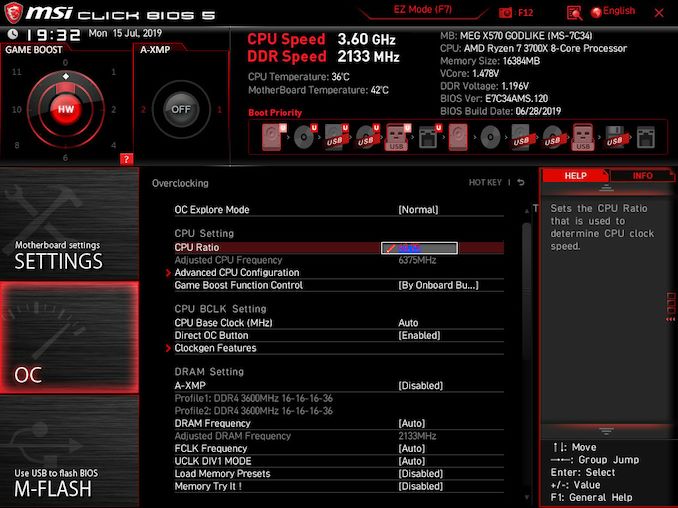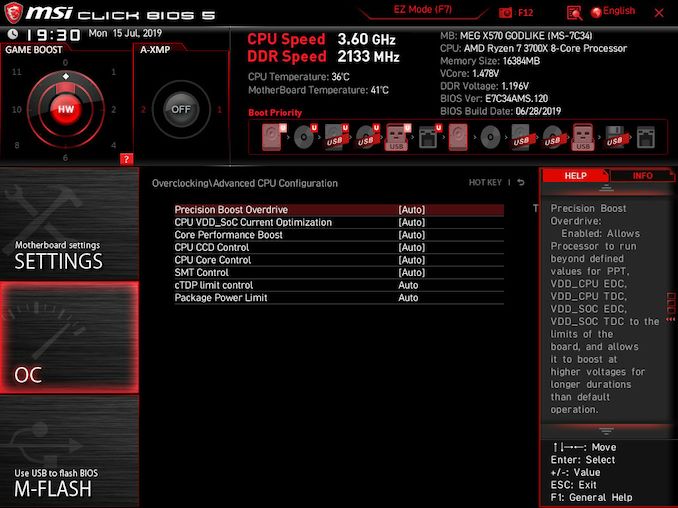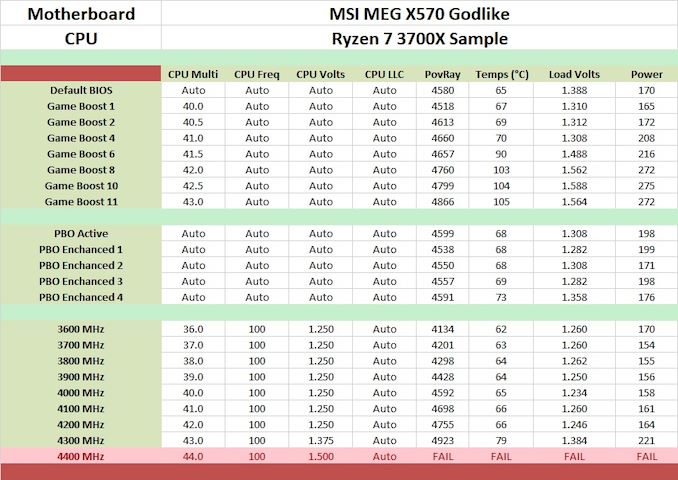The MSI MEG X570 Godlike Motherboard Review: Thor's Flagship
by Gavin Bonshor on August 28, 2019 12:00 PM EST- Posted in
- Motherboards
- AMD
- MSI
- 10G Ethernet
- Ryzen
- PCIe 4.0
- Ryzen 3000
- X570
- X570 Godlike
- MEG
Overclocking Ryzen 3000
Experience with the MSI MEG X570 Godlike
Overclocking with the Ryzen 3000 series hasn't exactly titillated users since its launch with there not being much headroom available. The biggest issue with this boils down to all-core overclocks being limited by the worst core of the chip. and the new 7 nm processors running quite warm. To get the best experience and results with the Ryzen 3000, users with good quality AIOs and custom water cooling yields the best outcome, and even with voltages of 1.375 V, these chips can run a little too warm for comfort.
The MSI Click BIOS 5 firmware is familiar to us and throughout the different chipsets including X399, X470, and Z390, the MSI MEG X570 Godlike uses the same design layout and setup. Within the OC section of the firmware, users can alter important settings such as the CPU ratio which can be changed in steps of 0.25 MHz, with relevant settings including CPU VCore, CPU Base Clock, and even FCLK frequency. Deeper into the firmware is settings to set the load line calibration (LLC) to a more aggressive or liberal profile, as well as all the Precision Boost Overdrive (PBO) settings.
The three main settings that PBO works from include package power tracking (PPT), thermal design current (TDC), and the electrical design current (EDC). All three of these can be set within the firmware under the advanced section of the Precision Boost Overdrive menu, although MSI has included four different PBO profiles for users to select from. The higher the setting, the higher the thermal and power draw will be, and it may not necessarily matter if a sub-par cooler is installed; it's noted that Ryzen 3000 processors work better when they are cooler.
There are seven different MSI Game Boost profiles to select from and users can access them via the dial at the bottom of the board, or through the firmware itself. The Game Boost profiles within the firmware can be accessed through the dial in the top left-hand corner. These profiles range from 4.0 GHz through to 4.3 GHz, and we've tested each of them below.
Overclocking Methodology
Our standard overclocking methodology is as follows. We select the automatic overclock options and test for stability with POV-Ray and OCCT to simulate high-end workloads. These stability tests aim to catch any immediate causes for memory or CPU errors.
For manual overclocks, based on the information gathered from the previous testing, starts off at a nominal voltage and CPU multiplier, and the multiplier is increased until the stability tests are failed. The CPU voltage is increased gradually until the stability tests are passed, and the process repeated until the motherboard reduces the multiplier automatically (due to safety protocol) or the CPU temperature reaches a stupidly high level (105ºC+). Our testbed is not in a case, which should push overclocks higher with fresher (cooler) air.
Overclocking Results
As it currently stands, MSI's Game Boost overclocking profiles need quite a bit of refinement, something they have informed us that these will be rectified with a new firmware revision; we will test this when we receive the board back from MSI. The issue with these is CPU VCore, or in a nutshell, too much of it which cross the board into the unsafe territory of the Ryzen 3000 processors safety limits; both in CPU VCore and in temperature. When we activated PBO and MSI's preset profiles for this, it didn't make much of an impact over the stock settings, which seems to be a reoccurring issue so far across the range of models we have tested so far.
Manually overclocking the MSI MEG X570 Godlike proved very fruitful and we managed to hit what seems to be the limits of our Ryzen 7 3700X testbed CPU with an overclock of 4.3 GHz all-cores with a CPU VCore of 1.35 V, which seems to be the brick wall for our processor. Even with a CPU VCore of 1.50 V, we couldn't get 4.4 GHz to remain stable when any kind of semi-intensive load was placed on the processor, although we did manage to boot into Windows 10 without fanfare with these settings. The performance wasn't throttled in POV-Ray throughout each of the frequencies tested and once the temperature limit of 110ºC is exceeded, the system will safely shut down. From 3.6 to 4.2 GHz, we managed to do this with a set CPU VCore of 1.250 V which did fluctuate slightly under load under the auto LLC setting. It is safe to say that the MSI MEG X570 Godlike doesn't have a VDroop issue and even at 4.3 GHz, a set CPU VCore of 1.375 resulted in a maximum load voltage of 1.384 V which isn't too far off the mark.













116 Comments
View All Comments
Oxford Guy - Thursday, August 29, 2019 - link
"As far as security issues they have both had their own issues over the years, although Intel has had a fair amount more."I don't think so. Intel's recent security track record is abysmal when compared with AMD's.
Qasar - Friday, August 30, 2019 - link
Sweetbabyjays the savings you are referring to for the MSI and Gigabyte boards, guess where it goes, the the HSF to cool that CPU, and remember, a 50 or 60 buck cooler, isnt going to cut it. you will need to get a mid high, to a high end cooler to keep that 9900k running at 4.8 ghz. and BTW... so what if the 9900k can hit 4.8 or 5 ghz.. big deal.. the Ryzen cpus are performing with in a few % of the intel equivent cpus while being 600+ MHz slower, all because the IPC is better then intels right now, once the ryzen cpus get their clocks higher, the gap, could flip flop... clock speed isnt the end all be all in performance, IPC is.. and AMD, for the time being, has the better IPC."
Then you say in another comment "they've won the performance and value games both at once." i never knew 10% less performance is better." it is when, again, the 10% deficit, is also at lower clocks compared it intel, as again.. IPC is better
Irata - Thursday, August 29, 2019 - link
First of all, there are many lower price options for X570.And to add to this, a high end Z390 motherboard is not cheaper - you can actually even spend more and if high Ghz is your aim, that is what you will need. Plus a high end ($$$) cooling solution.
Sweetbabyjays - Thursday, August 29, 2019 - link
True there are many X570 boards for cheaper, which in my opinion makes this board in particular, pointless. Spending $700 on an AM4 motherboard is in my opinion pure stupidity.The Z390 Godlike motherboard is available for $100 US cheaper. So a product for product comparison. Additionally, there are many other Silicon Lottery QVL Z390's that you can purchase for literally 1/3 of the price of this board. Furthermore, you can overclock a 9900k to 4.8 on pretty much any Z390/370 board.
If you're planning on getting your 3700x to 4.2GHz, you're not going to get there with a stock cooler, so you still need an expensive cooler.
AMD's main game is to be the value for money competitor, what i'm saying is a $700 motherboard at AM4 level literally takes that advantage and scrubs it. The only time that Zen 2 CPUs become the value option is when you need more than 8c/16t, or if you're going to go with an older AM4 chipset.
AshlayW - Thursday, August 29, 2019 - link
Then we both agree that this motherboard is pointless. It is, 700 bucks on this is a stupid thing, but when a decent X570 is 150-200 bucks, no problem. 3700X+X570 is hands down the better solution (read: also for gaming builds) than the 9900K+Z390 when all is considered.AMD doesn't have to be the "Value for money competitor" anymore, hon, they've won the performance and value games both at once. Ryzen is a premium brand now, and just happens to offer better value also. 3950X will render Intel's entire HEDT completely pointless, and 3900X already does half of it.
Sweetbabyjays - Thursday, August 29, 2019 - link
I totally agree that 3900x and 3950x really are the final nails in the X299 coffin.AshlayW - Thursday, August 29, 2019 - link
Or you could be a Smart consumer and get a B450 + Ryzen 9 3700X, for the same price as the 9900K alone, and have 90% the performance in every single scenario and having saved over a hundred dollars, considering you didn't have to buy the cooler, also? Oh, and the socket isn't dead-end and actually has an upgrade path.AshlayW - Thursday, August 29, 2019 - link
Ryzen 7*Sweetbabyjays - Thursday, August 29, 2019 - link
"B450 + Ryzen 7 3700X" I agree, this is a much more logical approach for most gamers and content creators on a budget.Oxford Guy - Thursday, August 29, 2019 - link
I'm also wondering why people ALWAYS push the 9900K instead of the 9700K to gamers, when 8 threads is enough for games and will be for long enough.